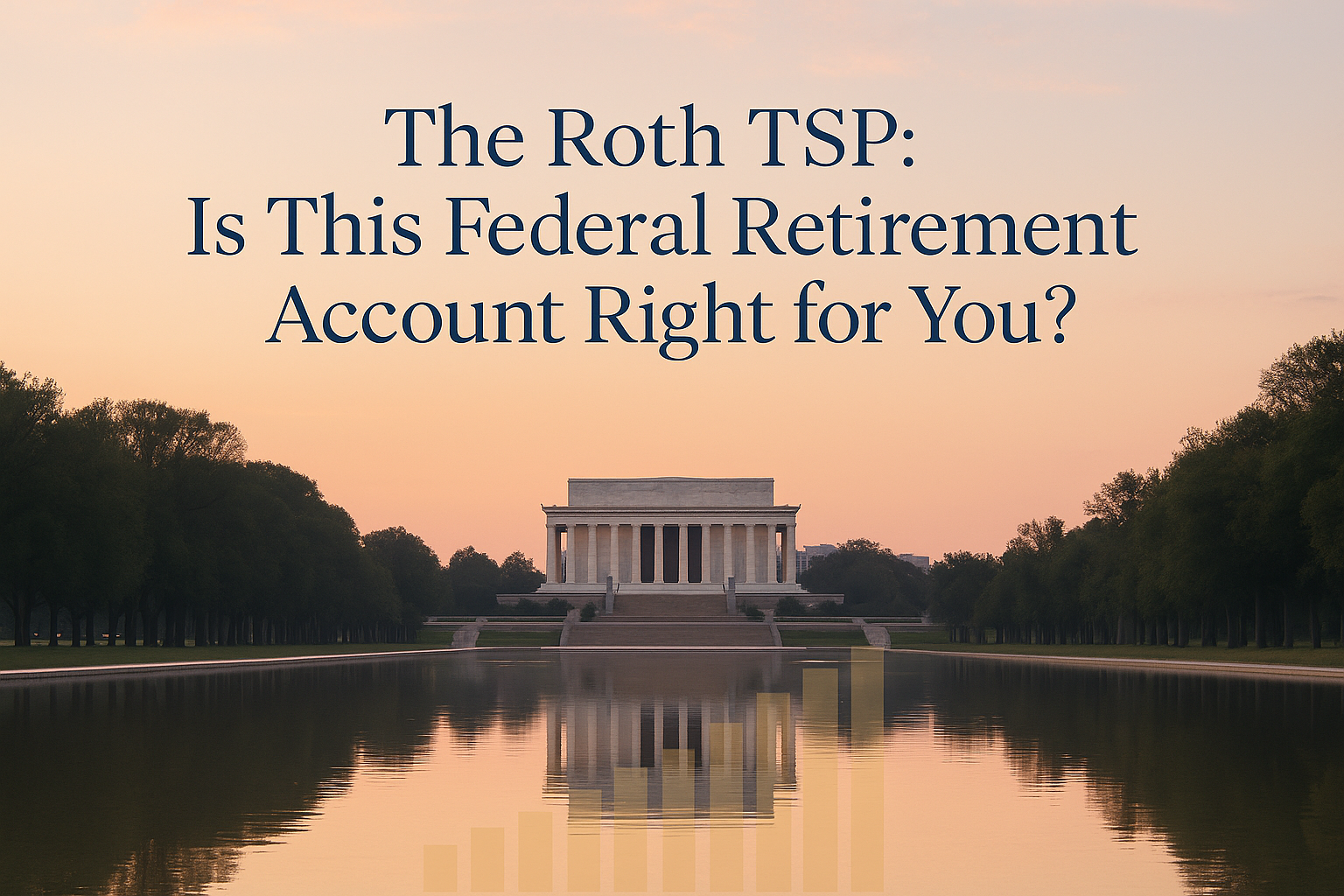The Roth TSP: Is This Federal Retirement Account Right for You?
Introduction: Why the Roth Question Matters Now
Are you a federal or military employee close to retirement age and feeling uncertain about future tax bills? It’s no secret that the national debt keeps expanding, and legislation like the SECURE Act has already shifted the retirement landscape. Many experts foresee potential tax rate increases down the road, raising the stakes for how you choose your Thrift Savings Plan (TSP) contributions. Will you pay those taxes now or retire with them looming over your withdrawal strategy?
That dilemma— often framed as Roth TSP vs. traditional TSP— is far from trivial. In light of rising deficits and the scheduled expiration of some current tax provisions, a “pay now or pay later” choice could have significant long-term implications. Choosing the right TSP contribution type isn’t just about the immediate change to your paycheck. It’s also about ensuring that once you exit federal service, you don’t face unnecessary tax surprises. The so-called five-year Roth clock, which determines whether your Roth TSP withdrawals will remain tax-free in retirement, can also catch you off guard if you start too late.
The good news is that you have options. In our decades of working with federal employees, we’ve seen firsthand that sound decision-making starts with personalized data. That’s why we developed the Fed-Expert Financial Blueprint, a proprietary planning process that incorporates your pension, Social Security, and state tax considerations to show you how Roth TSP contributions might fit into your overall financial picture. If you’re ready to see how upcoming legislation and tax rules could affect your TSP, sign up for one of our free Federal Retirement Planning Workshops. You can come away with clarity—and a solid plan.
Quick Refresher: How the Thrift Savings Plan Works
The Thrift Savings Plan (TSP) is the federal government’s version of a 401(k), offering you a simple way to invest for retirement. It includes several distinct investment funds (G, F, C, S, I) plus Lifecycle (L) funds designed to automatically rebalance as you get closer to retirement.
You can contribute up to $23,500 in 2025, and if you’re age 50 or older, you have an additional $7,500 catch-up allowance. The government will automatically deposit an amount equal to 1% of your basic pay each pay period into your TSP account (no matter what), and then match additional contributions up to 5%. That match goes into your TSP’s “traditional” bucket by default, even if you choose Roth TSP contributions. You’re not losing any match if you go Roth—it’s simply that the matching amounts must be pre-tax. You can split your contributions between traditional and Roth TSP as well.
If you need a more detailed walk-through of TSP funds, vesting timelines, and the mechanics of how to change your contribution elections, consider checking out the deeper TSP overview on the official TSP website. For now, let’s narrow in on what you really need to know about choosing Roth vs. traditional TSP contributions.
Roth TSP vs. Traditional TSP: Side-by-Side Breakdown
The central difference is straightforward: Traditional TSP contributions reduce your taxable income today, but you’ll pay taxes on withdrawals in retirement. Roth TSP contributions come out of your paycheck after taxes, but distributions can be tax-free down the road. However, there’s more nuance when you factor in your projected tax bracket, Social Security benefits, and the possibility of relocating to a different tax environment after retiring.
We often get asked if a Roth TSP yields the biggest paycheck in retirement. The answer depends on where your overall income and tax rates land by the time you need the money. For example, some federal employees discover that their FERS pension (plus Social Security and other income) pushes them into a higher bracket later on, making Roth TSP a stronger bet. Others anticipate their retirement income to be lower, tilting the scales toward the traditional TSP. State taxes also matter: If you plan to retire in a tax-friendly place, the incentive for going Roth might be diminished. If you’re staying put in a high-tax state, those Roth TSP withdrawals can feel like a welcome relief.
Below is a quick table that captures the essential distinctions between Roth TSP and traditional TSP:
| Feature | Roth TSP | Traditional TSP |
|---|---|---|
| Contributions | After-tax | Pre-tax |
| Tax on Growth | Tax-free | Tax-deferred |
| Tax on Withdrawals | 0% (qualified) | Ordinary income rates |
| RMDs | No (for account owner, starting 2024) | Yes |
| Impact on AGI | No reduction | Lowers AGI now |
For real-world numbers, try PlanWell’s Roth TSP Calculator (we factor in pension and state taxes). If you’d like an overview of how Roth TSP might pair up with your other benefits, consider signing up for our upcoming workshop to see these calculations in action.
Tax-Bracket Forecasting: The Deciding Factor
At the end of the day, Roth tsp decisions often hinge on whether you expect to be taxed at a higher or lower rate when you withdraw. Federal tax brackets are progressive, meaning the more you earn in retirement, the higher slice of it is taxed at the top marginal rate. Add in possible changes set to occur when certain provisions of the Tax Cuts and Jobs Act expire, and many soon-to-retire federal employees feel nervous about future taxes. Meanwhile, your FERS pension and Social Security can push your adjusted gross income up significantly in retirement, which can have a ripple effect—like incurring higher Medicare premiums (IRMAA surcharges) and turning a chunk of Social Security benefits into taxable income.
Take a hypothetical example: You’re 62, collecting your FERS pension and Social Security, drawing on your TSP for supplemental income. Consider the scenario below:
| Age | Income Components (Pension, SSA, TSP) | Estimated Marginal Rate | Impact if TSP Withdrawals Are Roth |
|---|---|---|---|
| 62 | $70,000 Pension + $20,000 SS + $10,000 TSP | 22% | Less taxable income; might avoid next bracket |
| 67 | $70,000 Pension + $30,000 SS + $20,000 TSP | 24% | Roth withdrawals keep your bracket stable |
| 72 | $70,000 Pension + $35,000 SS + $25,000 TSP + RMD | Possibly 24% or higher | No RMD on Roth portion, keeping taxes lower |
The line item “RMD” stands for Required Minimum Distribution, which you must start taking from the traditional portion of your TSP typically by age 73 or 75 (depending on birth year). As of 2024, Roth TSP balances are no longer subject to RMDs during the account owner’s lifetime, removing the need to roll to a Roth IRA solely to avoid those distributions. (See the SECURE 2.0 changes to TSP for more detail.) Clearly, forecasting your potential bracket can reveal whether paying taxes now might actually save you more money down the line.
Contribution Limits & Paycheck Impact
One of the biggest concerns about the Roth tsp is how after-tax contributions reduce your net paycheck. While the government’s match portion will always be pre-tax, your personal Roth TSP contributions don’t lower your taxable income like traditional TSP contributions do. That said, if your primary focus is maximizing tax-free income later, paying the taxes upfront could be rewarding. Keep in mind, your annual limit is currently $23,500 (plus a $7,500 catch-up if you’re 50 or older), whether you use Roth, traditional, or a blend.
The impact on your take-home pay can be illustrated easily. Let’s assume a GS-13, Step 8 federal employee decides to contribute 10%. These are rough figures for demonstration, but the table should help show the difference:
| Gross Pay (Annual) | 10% to Traditional | Net Pay (Traditional) | 10% to Roth | Net Pay (Roth) | Difference |
|---|---|---|---|---|---|
| $100,000 | $10,000 Pre-Tax | Higher, after reduced taxes | $10,000 After-Tax | Lower, since taxes are paid now | Varies by marginal rate |
All else being equal, your paycheck will shrink a bit more if you go Roth because you’re paying taxes immediately, but that same money potentially becomes tax-free in retirement. These trade-offs either make sense or don’t, depending on your overall plan—precisely why it’s so valuable to map different scenarios before committing.
When a Roth TSP Makes the Most Sense
There are several scenarios where a Roth tsp contribution typically shines. Younger military members, for instance, might be in a lower tax bracket today but anticipate higher earnings (and tax rates) later. In that case, locking in taxes at a lower rate can be a smart move. Or consider dual-income households expecting a robust retirement income that could push them into higher tax brackets in their 60s and beyond. Paying the tax now could significantly reduce your total lifetime tax hit.
State taxes can also tip the scale. If you expect to stay in a high-tax state, it’s often more appealing to use Roth contributions so your withdrawals remain entirely exempt down the road. (You might find our overview on retirement tax-friendly states helpful.) Another real-life example: Suppose a retiring O-5 in the military is wrapping up service and moving to Florida—which has no state income tax. In that situation, if you were already in a modest federal bracket, and Florida won’t tax your TSP distributions anyway, you might prefer to have taken the immediate deduction with a traditional TSP all along. But if you’re staying in a high-tax state, the Roth TSP might be the better choice, especially in your final working years.
Wondering if you’re “too old” to start a Roth TSP five years before retiring? Not necessarily. Even a short window of Roth contributions can set you up for a portion of your retirement income to be tax-free. Just remember—you must hold Roth TSP contributions for five calendar years (and be at least 59½) for qualified tax-free withdrawals, so timing is everything.
When Sticking with (or Adding) Traditional Is Smarter
We see plenty of situations where a traditional TSP remains a powerful choice. If your income is peaking, you have major bills to settle, or you’re paying off high-interest debt, maximum current tax savings might be more beneficial than paying taxes now. Some employees also enter phased retirement or experience a big drop in income right before retiring. In those years, it may make sense to continue enjoying the immediate tax break from traditional TSP contributions. Then, if your effective tax rate falls significantly once fully retired, you can manage your distributions in a strategic way. And yes, you can always toggle back to Roth contributions if your circumstances or tax outlook changes—TSP is flexible like that.
Blended Strategy & ‘Tax Diversification’
We don’t live in a world of all-or-nothing. Many federal employees choose a blended approach—some portion in a traditional TSP, some in a Roth tsp. That strategy can grant you “tax diversification,” so when you finally retire, you have both taxable and tax-free sources to draw from. (See our guide on optimizing traditional and Roth TSP contributions for more ideas.) With the new SECURE Act 2.0 rules requiring employees who earn over $145,000 to make catch-up contributions on a Roth basis starting in 2026, a blended approach might become even more common.
Our Fed-Expert Financial Blueprint dives deep into how much tax-free income you may need. Often, a 60/40 split is a starting point to explore, but your specifics—whether you earn special allowances, rely on a military pension, or anticipate late-career promotions—trump generic percentages. To see your own ideal mix, consider attending our free workshop. We’ll illustrate how blending your TSP contributions can hedge against uncertain tax environments.
Roth TSP vs. Roth IRA: Clearing Up Confusion
We’ve mentioned Roth tsp and Roth IRAs. Although both offer tax-free growth and withdrawals, there are key differences. Roth TSPs have no income limit and much higher contribution limits, making them especially attractive if you want to sock away large sums. Roth IRAs, however, dodge required minimum distributions (RMDs) entirely, and beginning in 2024 the Roth TSP does as well; prior to that, rolling to a Roth IRA was the workaround.
The following table sums up some nuances:
| Rule | Roth TSP | Roth IRA | Planning Tip |
|---|---|---|---|
| Contribution Limits | $23,500 + $7,500 catch-up | $6,500 + $1,000 catch-up | Roth TSP allows higher overall deferrals |
| Income Limits | No earnings cap | Phaseouts apply | High earners can still do Roth TSP |
| Withdrawals | No RMDs (starting 2024) | No RMDs | Rollover no longer required solely to avoid RMDs |
| Five-Year Clock | Applies within TSP | Separate five-year “timer” for each IRA | Track your start date carefully |
If you open a Roth TSP late in your career, merging it into an existing Roth IRA (which might have started the five-year clock years ago) can reduce or eliminate some waiting periods. For a deeper dive, check out our comparison of Roth TSP vs. Roth IRA. Just be sure to handle rollovers correctly and watch for the pro-rata rules that occasionally surface with partial transfers.
Implementation Checklist Before You Flip the Switch
While switching from traditional to Roth tsp is straightforward in many payroll systems (Employee Express, MyPay, etc.), it’s critical to double-check your withholdings and anticipate how your paycheck will change. Equally important, remember that your previously accumulated traditional TSP balance does not automatically become Roth. Only new contributions and their earnings will enter the Roth side of your TSP. Also, if you’ve never contributed to a Roth TSP before, your five-year clock starts with your first after-tax contribution. That’s crucial if you want tax-free withdrawals soon after hitting 59½.
Finally, review your beneficiaries. Adding a Roth TSP might also be a natural time to update or confirm who inherits your TSP assets. Since distribution dates and tax implications can differ, you want all of your account details to align with your overall estate planning objectives.
Common Mistakes We See and How to Avoid Them
Over the past 30+ years of helping federal employees, we’ve seen a few recurring missteps. One is underestimating how quickly pensions, Social Security, and TSP RMDs can push you into a higher tax bracket. Another is failing to realize that agency matches always go into the traditional bucket—some individuals panic, thinking they lose the match when selecting Roth. A third is misunderstanding the five-year rule, especially if you plan to retire in less than five years. For instance, a client we’ll call “Karen” made her first Roth TSP contribution at 59. She turned 62 before she met the five-year requirement, which meant she had to carefully plan partial withdrawals to avoid unexpected taxes. Had she started the Roth TSP just one year earlier, she would’ve enjoyed a fully qualified withdrawal plan on her entire Roth balance.
Tax planning is all about timing. That’s why we encourage you to run the numbers—and re-run them as your final working years shift. If you’re serious about never overpaying Uncle Sam, personalized modeling is key. Our Fed-Expert Financial Blueprint is built precisely for these “What if?” scenarios—because no two retirements are alike.
Conclusion: Is a Roth TSP Right for You?
No universal rule can declare Roth tsp the absolute winner or loser for every federal or military retiree. The crux is projecting both your current and future tax rates, factoring in state taxes, and deciding which scenario best protects your long-term wealth. If you think traditional TSP’s immediate tax break is worth it, that’s okay—especially if you currently earn a high salary. If you’d rather position yourself for potential tax-free income later, leaning into Roth TSP might be wise. Or, consider blending both to master the art of “tax diversification.”
As always, success comes from personalizing these strategies to your unique pay grade, pension plan, and family situation. Ready to see how a Roth TSP stacks up in your retirement equation? Let our dedicated financial advisors for federal employees pair your numbers with our Fed-Expert Financial Blueprint and run the scenarios. Sign up for one of our free Federal Retirement Planning Workshops to get a customized projection that helps you decide—Roth or traditional, or both—using data-driven insights and decades of federal retirement expertise.
FAQ
Is the Roth TSP subject to required minimum distributions?
Not for the account owner starting in 2024. Beneficiaries may still face distribution requirements.
Can I split contributions between traditional and Roth TSP?
Absolutely. You can elect any percentage combination as long as total contributions stay within the annual limit.
Does switching to Roth affect my agency match?
No. The match formula is the same, but agency contributions always go to the traditional side.
How soon do Roth TSP withdrawals become tax-free?
They are tax-free when you are 59½ or older and it has been at least five calendar years since your first Roth TSP contribution.
Do state taxes matter in the Roth vs. traditional decision?
Yes. Moving to a tax-free state in retirement can tilt the math toward traditional; remaining in a high-tax state often favors Roth.












